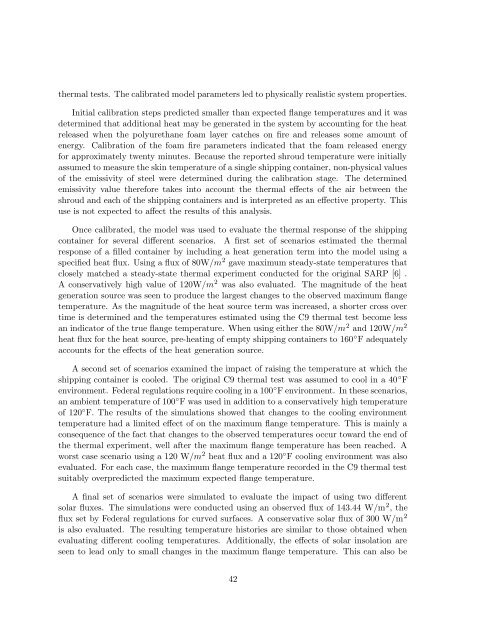Thermal Analysis of a H1616 Shipping Container - prod.sandia.gov ...
Thermal Analysis of a H1616 Shipping Container - prod.sandia.gov ...
Thermal Analysis of a H1616 Shipping Container - prod.sandia.gov ...
You also want an ePaper? Increase the reach of your titles
YUMPU automatically turns print PDFs into web optimized ePapers that Google loves.
thermal tests. The calibrated model parameters led to physically realistic system properties.<br />
Initial calibration steps predicted smaller than expected flange temperatures and it was<br />
determined that additional heat may be generated in the system by accounting for the heat<br />
released when the polyurethane foam layer catches on fire and releases some amount <strong>of</strong><br />
energy. Calibration <strong>of</strong> the foam fire parameters indicated that the foam released energy<br />
for approximately twenty minutes. Because the reported shroud temperature were initially<br />
assumed to measure the skin temperature <strong>of</strong> a single shipping container, non-physical values<br />
<strong>of</strong> the emissivity <strong>of</strong> steel were determined during the calibration stage. The determined<br />
emissivity value therefore takes into account the thermal effects <strong>of</strong> the air between the<br />
shroud and each <strong>of</strong> the shipping containers and is interpreted as an effective property. This<br />
use is not expected to affect the results <strong>of</strong> this analysis.<br />
Once calibrated, the model was used to evaluate the thermal response <strong>of</strong> the shipping<br />
container for several different scenarios. A first set <strong>of</strong> scenarios estimated the thermal<br />
response <strong>of</strong> a filled container by including a heat generation term into the model using a<br />
specified heat flux. Using a flux <strong>of</strong> 80W/m 2 gave maximum steady-state temperatures that<br />
closely matched a steady-state thermal experiment conducted for the original SARP [6] .<br />
A conservatively high value <strong>of</strong> 120W/m 2 was also evaluated. The magnitude <strong>of</strong> the heat<br />
generation source was seen to <strong>prod</strong>uce the largest changes to the observed maximum flange<br />
temperature. As the magnitude <strong>of</strong> the heat source term was increased, a shorter cross over<br />
time is determined and the temperatures estimated using the C9 thermal test become less<br />
an indicator <strong>of</strong> the true flange temperature. When using either the 80W/m 2 and 120W/m 2<br />
heat flux for the heat source, pre-heating <strong>of</strong> empty shipping containers to 160 ◦ F adequately<br />
accounts for the effects <strong>of</strong> the heat generation source.<br />
A second set <strong>of</strong> scenarios examined the impact <strong>of</strong> raising the temperature at which the<br />
shipping container is cooled. The original C9 thermal test was assumed to cool in a 40 ◦ F<br />
environment. Federal regulations require cooling in a 100 ◦ F environment. In these scenarios,<br />
an ambient temperature <strong>of</strong> 100 ◦ F was used in addition to a conservatively high temperature<br />
<strong>of</strong> 120 ◦ F. The results <strong>of</strong> the simulations showed that changes to the cooling environment<br />
temperature had a limited effect <strong>of</strong> on the maximum flange temperature. This is mainly a<br />
consequence <strong>of</strong> the fact that changes to the observed temperatures occur toward the end <strong>of</strong><br />
the thermal experiment, well after the maximum flange temperature has been reached. A<br />
worst case scenario using a 120 W/m 2 heat flux and a 120 ◦ F cooling environment was also<br />
evaluated. For each case, the maximum flange temperature recorded in the C9 thermal test<br />
suitably overpredicted the maximum expected flange temperature.<br />
A final set <strong>of</strong> scenarios were simulated to evaluate the impact <strong>of</strong> using two different<br />
solar fluxes. The simulations were conducted using an observed flux <strong>of</strong> 143.44 W/m 2 , the<br />
flux set by Federal regulations for curved surfaces. A conservative solar flux <strong>of</strong> 300 W/m 2<br />
is also evaluated. The resulting temperature histories are similar to those obtained when<br />
evaluating different cooling temperatures. Additionally, the effects <strong>of</strong> solar insolation are<br />
seen to lead only to small changes in the maximum flange temperature. This can also be<br />
42
















